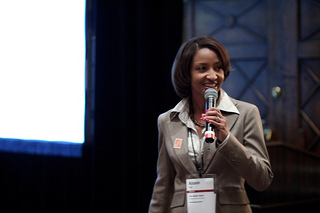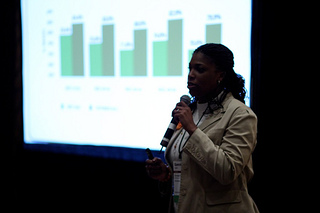It’s not every day you get recognized by Forbes for nailing transparency and candidate communication, but after talking to the Home Depot Employment and Branding Group, it’s easy to see why they’ve become a recognized leader in employment branding.
During the DirectEmployers 2012 Annual Meeting & Conference, Quenmiko (Miko) Covin and Alison Foy of the Home Depot Employment and Branding Group chatted with us about how they’ve designed such a powerful social media presence to support their employment brand, and how their DirectEmployers membership helps them achieve their goals.

The Home Depot's Employment and Branding Group presenting at DEAM12.
How is Home Depot using social media in its recruiting efforts?
We think it’s very important to have a touch point with an external candidate, a real touch point. More than where they can just come online and apply, but where they can actually interact with a recruiter. We know a lot of people want to actually interact – they have questions, comments or want to voice their opinion, so we make it a point to stay on top of those comments and reply to everything that’s on Facebook, Twitter and LinkedIn.
How do you do that within the corporate structure? Do you have someone assigned to monitor that content?
It’s interesting. You have to think about how you actually can manage both the monitoring and dialogue – one person can’t do it alone. We have a team member that manages Facebook from an internal perspective, another manages our Twitter account, and a different person manages our LinkedIn project. Even with those three factors along with an agency partner, we feel really stretched because that’s just responding. That’s just dialogue and a brand promise to make sure that we respond to everything that’s being asked. There are a whole slew of other items on the to-do list that we have to go through to be sure we’re engaging in a positive way while also providing fresh content. A lot of hands that go into assuring we respond, and that could be to just one post, one response or one question.
A lot of work was done initially when delving into the social media space. We conducted a lot of research and had several meetings both internally and with our agency partners to really make some decisions in advance as to how are we going to handle various situations. We did a soft launch in all of our media, so that also helped as well. We really did sort of ease into things in a way. We couldn’t just sort of come out and say “Hey, guess what everyone, we’re on Facebook!” and then be bombarded with a lot of comments, posts, questions, etcetera that we were not prepared to handle.
Would you recommend to employers who are just dipping their toe in the water with social media –where should they start and how should they move forward?
First they should ask themselves why they want to be in the social media space. Not just because everybody else is doing it, but is there a real need for the company to be in that space? Also examine if they’re prepared. Do they have a legal department, an agency partner and enough hands to really handle a social media strategy, because it really, really, could be a full time job.
They also need to consider content. What do they want to say once they get out there? Having a presence on social media is great, but they also have to say something. Companies can’t just allow everything to be generated from their external audience. You have to set up what you’re going to say and when, what’s relevant and when, and what your focus is going to be.
The focus should really enhance what it is you are trying to achieve and the reason you’re out there. For example, is it to engage additional candidates? Do you just want another space for your recruiters to utilize? Does that contain a number that you have to attain? Does it include a number of fans, followers and posts? Does it include how many different aspects of the recruiter’s time you’re going to put into it? The focus and the goal have to kind of mesh together and you have to work that out.
Other aspects include understanding limitations and what could go wrong first, and trying to create solutions before you go into the space. I recommend a soft launch where you’re able to start up on social media quietly and figure out what could go wrong or wasn’t considered. That approach helped us to ease into the space and still be present, yet have some room and time for adjustment.
It was also key for us to collaborate with internal partners. You can build internal champions through asking certain questions. Legally we needed to know what could we say and what should be avoided. If you’re talking to someone in government compliance, see what some of the more sensitive touch points in your space. Find someone in PR and see what the hot buttons are, or if there are some areas causing a lot of disdain… or even positive feedback that you can build upon. Internal communications, corporate communications – you have to have that kind of team, and it’s really just education through collaboration. That way, before you know it, you have people who are saying, “Yeah, they actually thought about everything, they thought things through, let’s do it,” because now you have everybody kind of weighing in, in a sense.
Getting that buy-in is a huge piece of it. Getting people to understand why it’s a great idea to have a careers Facebook page. To get people to understand that people do want to interact in this way, they want to find answers to everyday sort of questions like “Hey, I submitted an application and I didn’t hear back. What’s the length of time?” There is definitely a need for it, especially in our organization.
Do you recommend having a careers specific social media page as opposed to being worked in as part of the corporate page?
I think the main reason to have a separate page from your e-commerce or your customer page is that this is a different conversation. You want to treat it differently and that will help you engage the audience and have a dialogue based upon what they’re asking for. For us, we’re part of the HR organization, and its four people. The consumer pages, the profile pages have like 5- or 10-person teams. Sometimes, especially for us at the Home Depot, our customers and candidates can be one and the same, but we definitely want the focus to be on the employer component. And that’s why it’s good to have that separate dialogue from the customer/consumer facing portion.
Do you recommend dedicating a person, or team, solely to social media, or is it something that you’ve adopted into your structure?
In a perfect world, there would be a 10-person team to handle social media. Your employment marketing area is not necessarily a recruiter function. The recruiters have their jobs – they have recs to fill and a lot of components that constrain them. From our team’s perspective at the Home Depot, we’re just about the attraction of the candidate. Just think about the cost efficiencies on the back end utilizing an internal vendor as well. With social media, we have this career page obviously, but on those pages we also run promotions and content. So there’s always something going on that’s far and above a post and an answer or status update. Components like advertising, or when we’re running a contest or things of that nature, that is more involved and requires work on the back end to get it up and running, and to make a contest or promotion successful.
That doesn’t encompass staying on top of our competition and changes on social media platforms like LinkedIn page format updates, so to have those multiple arms would be terrific.

The Home Depot's Employment and Branding Group presenting at DEAM12.
Are there any other things you feel are really important to share with other employers who are venturing down the path to social media?
I think they should know the space, be comfortable in the space yourself, even if it’s at a basic level, but definitely engage the experts, the people who are comfortable in it, know exactly who your champion is to get it done, know your champions will be able to support you unless you have a full- fledged team all ready and prepared. One thing that we’ve learned is that even with the most planned strategy, things can come up. This is an ever-changing space, it’s an ever-growing space – so you have to be flexible. Not to the point where things are going to go your way, but truly flexible and open. Also admit when you don’t have the manpower to handle it. Just admit and move on or it could be very damaging.
So tell me, how did you connect with and become a Member of DirectEmployers Association?
Well, the Home Depot is a government contractor so there are a lot of requirements that come along with that. There are a lot of compliance requirements that we have to keep on top of as well. DirectEmployers definitely showed up four years ago as someone who would help us maintain our visibility from a compliance perspective, and provide support to our government compliance department for audit purposes. And they have delivered – I mean, their reporting is phenomenal. Turn around time is unbelievable. They’ve been able to pull things from four and five years ago sometimes, when necessary to respond to audits, it’s really been beneficial for us and we think it’s awesome.
It’s a great avenue to figure out exactly where the penetration is happening from an attraction perspective. A report we get actually breaks down by state where our traction points are. And where they actually distributed our jobs. Their military and other types of networks are amazing. We have all those touch points and can drill down reporting to the state level, so that is definitely valuable to figure out, for example, exactly where we may need up our game when it comes to attraction in California; to make sure we’re meeting the right compliance and state laws in terms of employment in California, which is different from any other state in the country; seeing exactly what is going on in Florida. Those reporting features help ensure us that we’re on top of the compliance end, that we remain in compliance and that we’re given the best value for our internal partners, especially from a government compliance and auditing perspective.

They also have a great relationship with the workforce agencies and most major cities and states, which is great. DirectEmployers also cross-posts all of our jobs to everywhere they need to be so we have that maximum reach, and again for the compliance portion of it. They just handle everything for us.
And DirectEmployers probably doesn’t even know that they help us maintain our employer brand, because it keeps us consistent. We don’t have to worry about who’s posting where in various places, and messages, verbiage and responsibilities are consistent across the board. So even from an employer marketing and branding perspective, they keep us consistent with our employer branding and our overall employment marketing message, which is something very important to our team.
Thank you again to the wonderful team at Home Depot. Catch them in one of our recent Help Wanted blog posts.
Don’t miss The Changing Face of Social Media Recruiting at the DirectEmployers 2013 Annual Meeting & Conference – register now and view the full agenda on the DEAM13 website.

